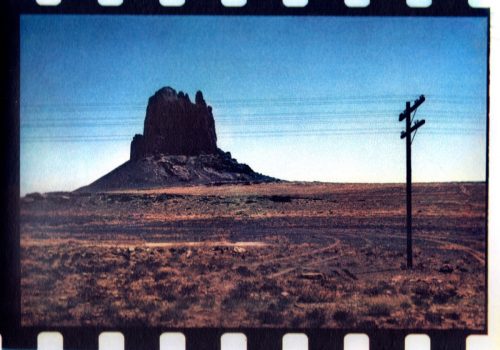Like many Europeans of the post-war generation, Bernard Plossu grew up with American culture, first with movies, then with literature, thanks to the authors of the Beat generation, without forgetting the music Jazz especially. But surprisingly, it is in Mexico, when he was barely 20 years old, that he discovered, in his own way, the New World. We are in the middle of the 60s and this young man fascinated by images, and freedom , did not not know then he would publish fifteen years later, in 1979, the manifesto of the French photographic scene: The Mexican trip. It is also from Mexico that he started travelling towards the California coast, in 1966, with his friend Bill Coleman, pacifist and member of the Students for Democratic Society, who introduced him to the beat and hippie culture. A few years later, it was again thanks to Coleman that he joined New Mexico to settle there, between 1977 and 1985, first in Taos then in Santa Fe.
Fascinated by the desert since he visited the Sahara with his father, at the age of 13, Bernard Plossu decided,in 1979, to walk across not only New Mexico, but also Arizona, Utah and Colorado, accompanied by his friends Doug Keats and Daniel Zolinsky.
The shadow of the Indians, especially the Apaches Chiricahuas, hovers over the immensity of these arid territories and Bernard Plossu would never rest to survey these places of memory and their sacred sites while confronting the silence and the minerality sublimated by incandescent light. It is, therefore, in line with the great American photographers, like Ansel Adams or Paul Strand who preceded him in these great spaces, except that it is out of the question for him to imitate them. He opts not for a large format camera, but for a Nikkormat 24×36 with a 50mm lens. His prints are no more than 12 cm by 8 cm, as told by the American historian Stuart Alexander, in his introductory text to the Garden of Dust (published in 1989 and dedicated to the memory of Cochise): “Plossu considers this format as the perfect size. Smaller, they would not be readable. Larger, the image would not hold anymore. The grain of the film would be too present and the sense of concentration and intimacy would be lost. Watching these prints is an experience similar to watching landscape daguerreotypes.” The “timelessness” and “out of range”, in contrast to images in motion, sometimes even at the limit of vagueness, which have made his reputation, trace an initiatory path that will open to Bernard Plossu new horizons , much later, and this time on the Old Continent. This set of images, presented as part of “Présence (s) photographie” is exhibited for the first time in France. Several series – “The Garden of Dust”, “Cochise’s Stronghold”, “Chaco Canyon” and “White Pictures of White America”, “Southwest electric poles” – are unpublished. They are complemented by the series “So Long” and a dozen photograms from the series “8 / Super 8”. A way to remember that Bernard Plossu also knew how to handle a small camera in a country that worships CinemaScope.
Philippe Séclier, curator of the exhibition
Bernard Plossu – Échappées américaines, Inédits
November 17 – December 2nd
Centre d’art Espace Chabrillan
127 rue Pierre Julien
26200 Montélimar
France
















